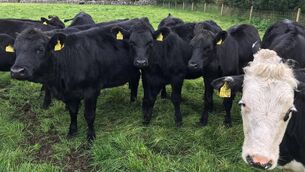New veterinary prescriptions for antibiotics to last 5 days

The new rules are designed to ensure the most critically important antibiotics are only used where there is no alternative
A prescription for livestock antibiotics will last only five days, but the new rules from January 28 next for antiparasitic dosing products will be more lenient, with prescriptions lasting longer, according to trade sources.
A National Veterinary Prescription System (NVPS) is planned to be operational early next year, in which a farmer’s vet will generate the prescription online (for animals under their care). Under the new plans, veterinary prescriptions will also be required for medicated feed.
The online prescription will issue via a centralised department system, and will also be used as the method of measuring the use of veterinary medicinal products on each farm, particularly antibiotics.
The NVPS will result in a prescription being made available to a farmer by choice of email, text, or on paper. Farmers can then show the prescription to a licensed merchant, veterinary pharmacist, or their veterinary practitioner, to get it dispensed.
The focus of these new regulations is to protect human health and address the challenge presented by antimicrobial resistance, which can result from the overuse of common antibiotics.
The new system keeps Ireland well ahead of new European Commission obligations to collect in-depth data on the quantity of antimicrobial medicinal products used in animals by type and sector.
By 2027, Member States will be required to collect data on veterinary medicine sales for all food-producing animal species, with data recording requirements to include all other kept animals by 2030.
All current suppliers of veterinary medicines will continue to be legally permitted to supply these medicines.
The farmer can produce the prescription identification details directly to the dispenser of their choice.
So from January 28, all dosing products will still be available to purchase from a trained individual (responsible person) in co-ops, veterinary pharmacies and veterinary practices, but a prescription will be required.
The main objectives of the new regulations include freeing up the availability of veterinary medicines across the EU, whilst also introducing some additional control to address the clear evidence of the sustained escalating resistance to certain veterinary medicinal products.
Department of Agriculture sources have said responsible persons employed in licensed merchants, veterinary pharmacists and veterinary practitioners will continue to play important advisory roles in supplying veterinary medicines to farmers.
All dispensers registered for the NVPS will have equal access to dispensing antiparasitics.
The system is being developed in such a way as to allow for alternative or generic products, based on the active substances detailed on the prescription, to be dispensed as an alternative to a named product, as necessary.
Those behind the new system claim this concession could reduce costs to farmers and provide more choices and opportunities to retailers.
According to the DAFM, decoupling, which is breaking the link between the prescriber and dispenser, will not feature in the new system.
Decoupling was recommended by some stakeholders, and in a report on the new system by the Oireachtas Agriculture Committee.
But legal advice to the department on this issue indicated that a sound evidential basis in veterinary medicine is required to justify any partial or full prohibition on veterinarians selling the veterinary medicines that they prescribe.
Such decoupling could not be solely for the purpose of economically assisting one sector of an industry over another (which would be seen as providing State Aid to one sector over another).
The department said there is no such evidential basis, and therefore, decoupling is not an option legally available to it.
As part of the preparation for the new system, the department carried out research and analysis into the distribution and accessibility to farmers of large-animal veterinary services in rural Ireland. This investigation revealed that large-animal veterinary services are available within 20km to over 95% of Irish livestock farms.
According to the department, meeting these higher levels of controls in the EU veterinary regulations will be pivotal in Ireland’s ability to maintain agri-business employment and food export figures (including €5.1 billion of dairy produce and beef at €2.3 billion, in 2020.)
The department’s preparation for the new system also includes a range of activities to reduce and reverse, wherever possible, the increased resistance patterns in both antibiotics and antiparasitics.
Meanwhile, figures released this week by the UK's Veterinary Medicines Directorate show an overall reduction in the sales of antibiotics, including highest priority critically important antibiotics (HP-CIAs), for food-producing animals between 2019 and 2020.
Since 2014, it translates into a 52% reduction in total antibiotics sales and a 79% fall in drugs classed as the 'Highest Priority-Critically Important Antibiotics'.
The report also notes improvement in antibiotic usage data across most livestock groups and includes veterinary antibiotic sales figures for cats and dogs, which show a 7% reduction in the year from 2019.









